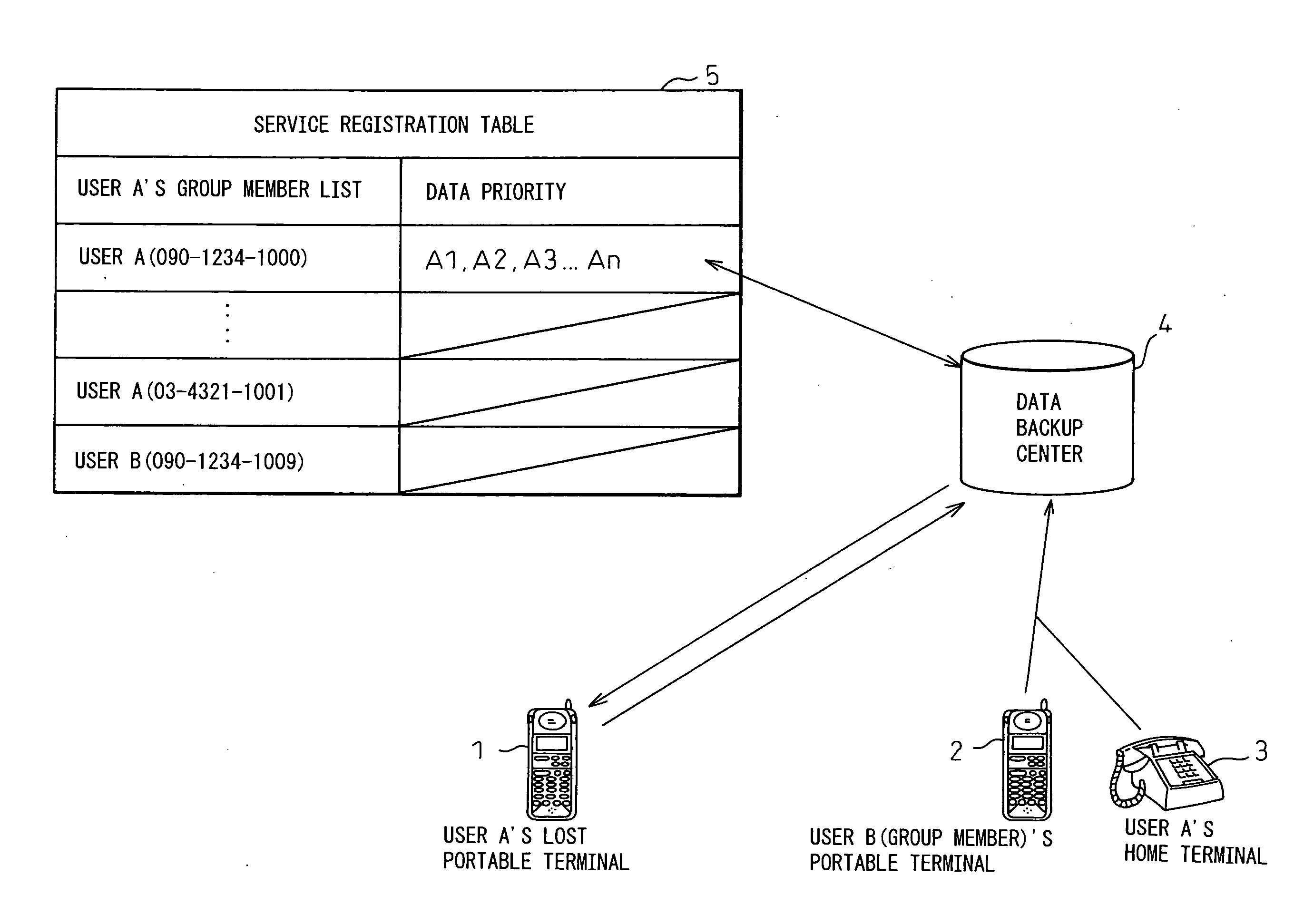Portable wireless terminal and its security system
a wireless terminal and wireless technology, applied in the direction of substation equipment, electrical equipment, eavesdropping prevention circuits, etc., can solve the problems of improper use of tolls, confidential data being used improperly, etc., to prevent interception, secure the removal of retained data, and ensure the security of the terminal
- Summary
- Abstract
- Description
- Claims
- Application Information
AI Technical Summary
Benefits of technology
Problems solved by technology
Method used
Image
Examples
first embodiment
[0061]FIG. 3 shows the present invention. FIG. 4 schematically shows an example of user authentication when backup is required.
[0062] In this example, user A registers his / her cellular phone with the backup center 4 by using the registrant data management function 4-1 of the backup center 4 in advance. According to the service registration table 5 of FIG. 1, the cellular phone 1 (TEL: 090-1234-1000) of user A and the backup priority of its data (A1, A2, A3, . . . , An), the cellular phone 2 (TEL: 090-1234-1009) of user B who is one of user A's group members, and so on are registered (S101).
[0063] After that, if user A's cellular phone 1 is lost, user A requests the backup center 4 to backup the retained data of the cellular phone 1 by borrowing user B's registered cellular phone 2 (S102). In response to this request, the registrant authentication function 4-2 in the backup center 4 refers to the service registration table 5 and, based on the physical authentication of the phone num...
second embodiment
[0071]FIGS. 5A-5C show the present invention.
[0072] Here, in place of or along with the backup process of FIG. 3, there is schematically shown an example of encryption of stored data 12 of the cellular phone 1. In the context of the sequence shown in FIG. 3, the lock request (S105) or the data delete request (S111) is replaced with an encryption request in this example.
[0073] As shown in FIG. 5A, also in this example, the same key information as that of FIG. 4 is used, and thus, when the access control function 1-1 detects that the 2-bit value [1,0] (encryption of the retained data 12) is copied to the key information memory 11, the data encryption function 1-5 starts to encrypt the retained data 12 by using the public key (FIG. 5B). This public key may either be included in the message of the encryption request received from the backup center 4 or owned by the data encryption function 1-5.
[0074] In FIG. 5C, user A, who is the authorized owner of the lost cellular phone 1, decrypt...
third embodiment
[0075]FIG. 6 shows the present invention. Further, FIG. 7 shows an example of a communication sequence using split communication paths.
[0076] In this example, in the process of transmitting the backup data (S108) of FIG. 3, there is schematically shown an operational example in which the data forwarding address change function 1-2, the data splitting function 1-3 and the data transfer function 1-4 of the cellular phone 1 transmit the data that is split into a plurality of paths, and an operational example, in which the data assembly function 4-4 of the backup center 4 assembles and restores the received data.
[0077] In FIG. 6, user A's lost cellular phone 1 receives radio waves from wireless base transceiver stations (BTS) 21, 31 and 41 in a plurality of areas. When the plurality of base transceiver stations 21, 31 and 41 that are communicatable are detected, the data forwarding address change function 1-2 cyclically switches between the communication paths of these base transceiver...
PUM
 Login to View More
Login to View More Abstract
Description
Claims
Application Information
 Login to View More
Login to View More - R&D
- Intellectual Property
- Life Sciences
- Materials
- Tech Scout
- Unparalleled Data Quality
- Higher Quality Content
- 60% Fewer Hallucinations
Browse by: Latest US Patents, China's latest patents, Technical Efficacy Thesaurus, Application Domain, Technology Topic, Popular Technical Reports.
© 2025 PatSnap. All rights reserved.Legal|Privacy policy|Modern Slavery Act Transparency Statement|Sitemap|About US| Contact US: help@patsnap.com



